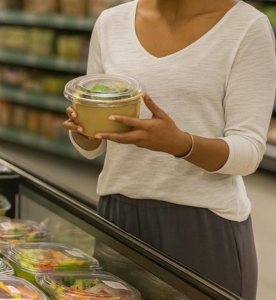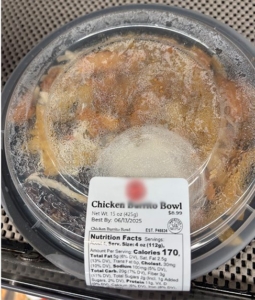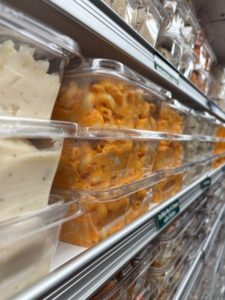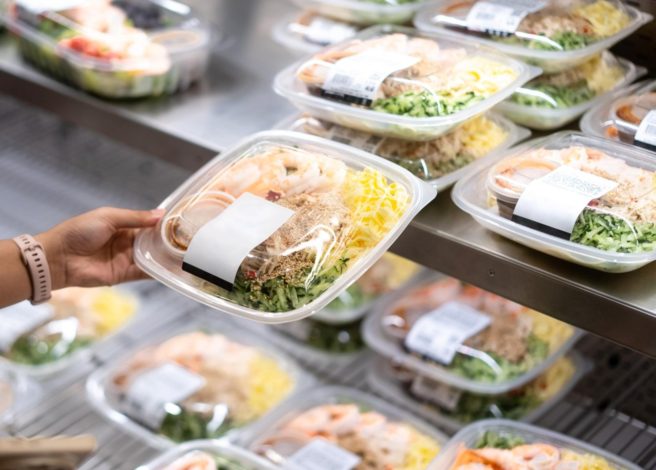Listen to the audio recording of this blog post or check out the featured Podcast about this topic.
At a Glance
- Packaging drives consumer decisions in just three seconds, making it the critical first impression that can make or break a product.
- Poor packaging choices — cracks, weak seals, dull clarity, or mismatched branding — undermine quality and push shoppers toward competitors.
- Packaging impacts far more than sales: it affects shelf life, waste, distribution costs, and long-term brand reputation.
- Strategic, well-designed packaging builds trust, communicates value, and drives repeat purchases by aligning with consumer expectations.
Your breakfast sandwich might be legendary. Your sustainability efforts could win awards. The product protection strategy you’ve implemented might be bulletproof. But if your packaging doesn’t communicate these wins in those crucial first moments, none of it matters.
Every day, food business pros face a harsh reality. Their products succeed or fail based on shoppers’ quick choices. As you perfect your recipes, your packaging can either boost your story or undermine your hard work.
At Inline Plastics, we’ve been in the business of fresh food packaging for over 55 years, and we know the importance of packaging in telling your product (and brand) story.
This article examines how packaging serves as your brand’s first spokesperson. Those crucial first three seconds can shape your product’s future. It explains how to shift your packaging from a basic container to a vibrant revenue generator. This change allows you to capture every opportunity for profit.
The Three-Second Sales Window Every Food Business Faces
Let’s start with a simple exercise: Walk through any grocery store and watch how shoppers move (no, not how they’re discreetly dancing to the early 90s Madonna track that store always plays). These consumers aren’t just browsing. They’re scanning, evaluating, and deciding quickly. Research from the German media company, EyeSquare, shows consumers make purchasing decisions within three seconds of first contact with a product. Three seconds. That’s barely enough time to read a brand name, let alone digest a value proposition.
For food business professionals, this reality hits differently. Every product reflects hard work. It includes recipe development, sourcing decisions, quality control, and meeting regulations. But all that expertise won’t help if your packaging doesn’t grab attention and show value in those key moments.
When Good Products Get Overlooked Because of Poor Packaging Choices
 Heartbreaking losses occur when great products go unnoticed because of poor packaging. A cracked hinge suggests poor quality control (or that your packaging lost a fight with a badger). A weak seal hints at freshness issues. Dull clarity hides the vibrant colors that could trigger purchase impulses. Each minor flaw in packaging can make customers doubt your brand. This doubt may push them to competitors, which you want to avoid. After all, a badger attacking your products is not the only concern!
Heartbreaking losses occur when great products go unnoticed because of poor packaging. A cracked hinge suggests poor quality control (or that your packaging lost a fight with a badger). A weak seal hints at freshness issues. Dull clarity hides the vibrant colors that could trigger purchase impulses. Each minor flaw in packaging can make customers doubt your brand. This doubt may push them to competitors, which you want to avoid. After all, a badger attacking your products is not the only concern!
Consider the prepared meal section of your typical retail store. Shoppers want to see fresh ingredients, rich colors, and appetizing presentations. When packaging lacks clarity or shows signs of stress, even the most carefully crafted culinary creation, such as your Sensational Southern Seafood Soufflé, looks questionable (not because of the taste — we’re sure it’s a hidden treasure of the sea). The result? Lost sales that have nothing to do with product quality and everything to do with packaging performance.
These losses compound over time. One missed sale becomes a pattern. A pattern becomes a reputation. A reputation becomes a business challenge that even the best marketing budgets struggle to overcome.
What Your Current Packaging Might Be Accidentally Communicating
Packaging problems go beyond obvious failures. Sometimes the message mismatch is subtle but damaging, like a comment on social media that causes you to spit coffee at your phone in shock. The disconnect becomes costly when your packaging contradicts your brand positioning. Shoppers receive mixed signals and default to competitors with clearer, more consistent messaging.
Premium products in budget-level packaging confuse shoppers about positioning. Why are the lobster claws on your seafood soufflé sticking out of the package like a zombie rising from the grave? Maybe that could be considered an “obvious failure”?
Sustainability-focused brands using non-recyclable materials create cognitive dissonance. A product in packaging that brags about being made with recycled content but is as recyclable as toxic waste is confusing to consumers.
Also, innovation-driven companies with outdated packaging signal that they’re falling behind. You can’t serve a cutting-edge soup born from molecular gastronomy — think beakers, sea foam, and liquid nitrogen — in an aluminum container that looks like World War II rations.
The Hidden Costs of Packaging That Doesn’t Perform
 When packaging underperforms, the costs extend far beyond individual lost sales. Poor seal integrity leads to product returns, damaged brand reputation, and expensive recalls. Inadequate barrier properties result in shortened shelf life, increased waste, and retailer complaints. Weak structural integrity causes distribution problems and damaged goods claims.
When packaging underperforms, the costs extend far beyond individual lost sales. Poor seal integrity leads to product returns, damaged brand reputation, and expensive recalls. Inadequate barrier properties result in shortened shelf life, increased waste, and retailer complaints. Weak structural integrity causes distribution problems and damaged goods claims.
These operational costs often dwarf the initial savings from choosing cheaper packaging options. But the real damage is harder to quantify:
- Customers who never return
- The retailers who lose confidence
- The word-of-mouth referrals that never happen
- The opportunity for everyone to see the next soufflé you’ve got up your sleeve (maybe avoid seafood?)
Food industry leaders understand that packaging performance is key to profits. It drives sales and helps avoid extra costs (when the right container is doing its job).
How Strategic Packaging Becomes Your Silent Sales Force
Excellent packaging works harder than any sales representative. It communicates quality, builds trust, and triggers purchase decisions without saying a word. Consistent packaging leads to great customer experiences. This encourages repeat purchases and builds brand loyalty.
The key is alignment. Your packaging should amplify your product’s best qualities while addressing category-specific challenges. Cold-case items need clarity and tamper protection to build confidence. Hot foods require temperature retention and reheating performance. Prepared meals demand durability and leak resistance for transportation and storage.
Packaging That Captures Every Sales Opportunity
 Successful packaging optimization starts with understanding your customer’s journey. What draws their initial attention? Can their confidence in the product grow during consideration? What ensures satisfaction after purchase? Each touchpoint represents an opportunity to strengthen or weaken the relationship.
Successful packaging optimization starts with understanding your customer’s journey. What draws their initial attention? Can their confidence in the product grow during consideration? What ensures satisfaction after purchase? Each touchpoint represents an opportunity to strengthen or weaken the relationship.
The best packaging solutions address multiple objectives simultaneously. They protect product integrity while enhancing visual appeal. They meet regulatory requirements while supporting sustainability goals and control costs while maximizing shelf impact.
Because There’s No Second Chances in Packaging
Your packaging investment should lead to clear benefits. This includes higher sales speed, less waste, and happier customers. When packaging works effectively, it not only avoids issues but also fosters growth and new product ideas.
The most successful food businesses treat packaging as a strategic asset rather than a necessary expense. They understand that all aspects, from material selection to structural design, affect their ability to compete in crowded retail settings.
At the end of the day, your product’s success depends on more than just great taste or superior quality. It depends on packaging that ensures your target customers choose you in those critical first three seconds — and keep choosing you for years to come.
Are you excited to talk more about packaging? We know you are! Visit our Learning Center today and explore a wide range of topics for your next food preservation discussion. Your friends (who have very specific interests like you) will love it!

